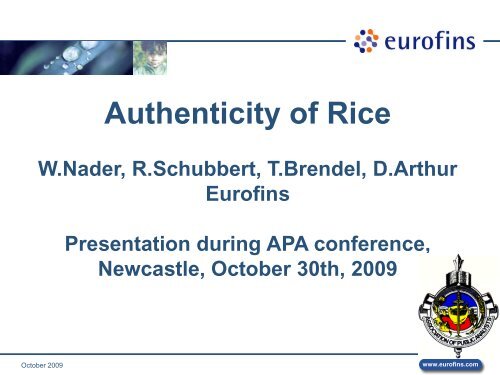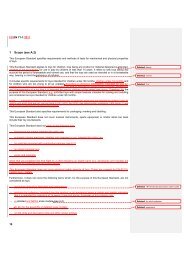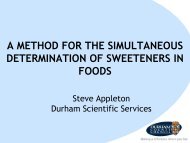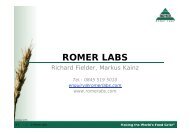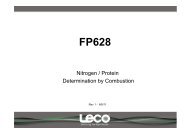Presentation - Association of Public Analysts
Presentation - Association of Public Analysts
Presentation - Association of Public Analysts
Create successful ePaper yourself
Turn your PDF publications into a flip-book with our unique Google optimized e-Paper software.
Authenticity <strong>of</strong> Rice<br />
W.Nader, R.Schubbert, T.Brendel, D.Arthur<br />
Eur<strong>of</strong>ins<br />
<strong>Presentation</strong> during APA conference,<br />
Newcastle, October 30th, 2009<br />
October 2009<br />
www.eur<strong>of</strong>ins.com
Joint effort <strong>of</strong> the Eur<strong>of</strong>ins network<br />
Eur<strong>of</strong>ins <strong>Public</strong> Analyst Service, UK<br />
Eur<strong>of</strong>ins Global Control, Hamburg<br />
Eur<strong>of</strong>ins Medigenomix, Munich<br />
RiceLab, Pakistan<br />
Eur<strong>of</strong>ins India<br />
October 2009 <strong>Association</strong> <strong>of</strong> <strong>Public</strong> <strong>Analysts</strong> Conference 2009 2
Current issues with rice<br />
Nr. Topic Status Future development<br />
1<br />
Issue probably resolved for the USA,<br />
GMO<br />
persistent in China<br />
Many new GMOs in agriculture expected soon<br />
2<br />
3<br />
4<br />
5<br />
6<br />
7<br />
8<br />
Mycotoxins<br />
Pirimiphos-methyl<br />
Other pesticides<br />
Rice authenticity<br />
Arsenic<br />
Packaging materials<br />
Cadmium<br />
Issue seems resolved with new<br />
Commission Regulation 669/2009, 5 ppb<br />
for afla B1 and 10 ppb for sum in cargo rice<br />
Reduction <strong>of</strong> MRL from 5 to 0.05 ppm<br />
possible.<br />
So far pesticides no big issue for rice on<br />
EU/RASFF level<br />
Issue <strong>of</strong> quinclorac has been resolved with<br />
new EU pesticide regulation<br />
Code <strong>of</strong> Practice for Basmati rice brought<br />
clarity for UK<br />
FSA recommendation against rice milk for<br />
toddlers<br />
Migration <strong>of</strong> phthalates observed from<br />
recycled paper package<br />
Review <strong>of</strong> current limits in food<br />
Ochratoxin A and Fusarium toxins not considered<br />
to be a risk in rice<br />
Commission requires data to support further use.<br />
Further reduction <strong>of</strong> MRLs probable for certain<br />
pesticides.<br />
Water soluble pesticides like acetamiprid might<br />
become an issue<br />
Interpretation <strong>of</strong> import duty exemption rules are<br />
not clear yet ((EC) No 972/2006). Thai fragrent<br />
rice authenticity under evaluation in France<br />
New scientific opinion expected from EFSA and<br />
new limits for rice<br />
Comprehensive declaration <strong>of</strong> compliance required<br />
for packages made out <strong>of</strong> plastic since May<br />
Rice not considered to be a risk, but will be<br />
monitored<br />
October 2009 <strong>Association</strong> <strong>of</strong> <strong>Public</strong> <strong>Analysts</strong> Conference 2009 3
Basmati rice – some facts<br />
• Export India (2006/2007): 1.1 million tons / 700 million $<br />
• and Pakistan (same FY): 900.000 tons/ 570 million $<br />
EU Import (2002/2003): > 270.000 tons, 70 % to UK<br />
• Price: 600 to 700 €/ton, dehusked Pusa Basmati rice<br />
• In comparison non-Basmati long grain rice: 300 to 350 €/ton, dehusked<br />
US long grain<br />
Yields:<br />
• traditional Basmati rice (Type III): 3 – 3.5 tons / ha<br />
• inbred Basmati rice (PUSA): 4 – 7 tons / ha<br />
• long grain non-Basmati rice: > 8 tons /ha<br />
•EU rice import tariffs: 65 € / ton for dehusked and 175 € / ton for milled<br />
rice<br />
• Import tariff exemption: 9 basmati varieties (dehusked)<br />
October 2009 <strong>Association</strong> <strong>of</strong> <strong>Public</strong> <strong>Analysts</strong> Conference 2009 4
Basmati Varieties<br />
Taraori<br />
Basmati 370<br />
Haryana<br />
Paddy<br />
Dehusked<br />
Milled<br />
October 2009 <strong>Association</strong> <strong>of</strong> <strong>Public</strong> <strong>Analysts</strong> Conference 2009 5
Developments on the European level<br />
October 2009 <strong>Association</strong> <strong>of</strong> <strong>Public</strong> <strong>Analysts</strong> Conference 2009 6
Approved Basmati varieties<br />
Basmati rice varieties eligible for a zero EU import duty<br />
Basmati 217 (I)<br />
Ranbir basmati (IET 11348) (I)<br />
Basmati 370 (I, P)<br />
Super basmati (P)<br />
Basmati 386 (I)<br />
Taraori basmati (HBC-19, Karnal Local) (I)<br />
Kernel basmati (Basmati Pakistan) (P)<br />
Type –3 (Dehradun) (I)<br />
Pusa basmati (IET 10364) (I)<br />
Other Basmati rice varieties approved by India and Pakistan<br />
Basmati 198 (P)<br />
Kasturi (IET 8580) (I)<br />
Basmati 385 (P)Mahi Suganda (I)<br />
Haryana Basmati (HKR 228/IET 10367) (I)<br />
Punjab Basmati (Bauni Basmati) (I)<br />
October 2009 <strong>Association</strong> <strong>of</strong> <strong>Public</strong> <strong>Analysts</strong> Conference 2009 7
Survey by Eur<strong>of</strong>ins <strong>Public</strong> Analyst Service<br />
Survey 2008, Eur<strong>of</strong>ins <strong>Public</strong> <strong>Analysts</strong><br />
21,6%<br />
3,7%<br />
42,5%<br />
32,1%<br />
0 % (PURE)<br />
0.1 %- 7 % (PASS)<br />
7 % - 13 % (BORDERLINE)<br />
> 13 % (FAIL)<br />
FSA 2002/2003 Eur<strong>of</strong>ins 2008<br />
% non-Basmati 363 samples 132 samples<br />
0 54,0% 3,7%<br />
< LOQ 10,0% 6,7%<br />
LOQ- 10 14,0% 44,8%<br />
10 - 20 6,0% 34,3%<br />
20 - 30 4,0% 3,7%<br />
30 - 40 2,0% 3,7%<br />
40 - 50 1,0% 0,7%<br />
50 - 60 1,0% 0,0%<br />
> 60 9,0% 2,2%<br />
October 2009 <strong>Association</strong> <strong>of</strong> <strong>Public</strong> <strong>Analysts</strong> Conference 2009 8
Results from ÖKOTEST Study, 2006<br />
October 2009 <strong>Association</strong> <strong>of</strong> <strong>Public</strong> <strong>Analysts</strong> Conference 2009 9
Satellite DNA<br />
Different alleles arising from<br />
variation <strong>of</strong> tandem repeat length<br />
during crossing over<br />
October 2009 <strong>Association</strong> <strong>of</strong> <strong>Public</strong> <strong>Analysts</strong> Conference 2009 10
Alleles <strong>of</strong> microsatellite markers for rice varieties<br />
RM1 RM223 M16 RM202 RM44 RM201 RM229 RM241 RM171 RM55<br />
Basmati Varieties<br />
Taraori W W Z Y Y X Y Y Y X<br />
Basmati 386 W W Z Y Y X Y Y Y X<br />
Kernal W W Z Y Y X Y Y Y X<br />
Basmati 370 W W Z Y X X Y Z Y Z<br />
Dehradun W W Z Y X X Y Z Y Z<br />
Basmati 198 Y W Z X (Y) X X Y Z Y Z<br />
Kasturi W V Y Y W X Y Z Z Y<br />
Basmati 385 Y W Z X Y X Y Z Y Z<br />
Super Basmati W W Z Y X X Y Z Z X<br />
Pusa Basmati W W Y Y Y X X Y Z Y<br />
Ranbir Basmati W (-1) Y Z Y X (+1) X Y Z(+2) Y Z<br />
Mahi Sugandha Y X Z X W Z X Z Z Y<br />
Punjab Basmati Y(+ 2) Y Z X X (+1) X Y X (-4) Y Z (+3)<br />
Punjab Basmati Z (+5) Y Z X X (+1) X Y Z Y Z<br />
Haryana Basmati Z Y Y X W X X Y Z Y<br />
Haryana Basmati Z Y Z Y W X X Y Z Y<br />
typical Basmati adulterations<br />
Sherbati W (Z) Z (Y) Y X (Y) W Z X X (Y) W (Z,Y) Y<br />
Pak 386 Y X Y Y W Z Y Y Z Y<br />
Thai scented rice<br />
Hom Mali Z (+5) V Y Y W (+2) W X Y (-2) Z Z (+2)<br />
Pathumthani Z (+5) V Y Y (+4) W W X Y Z (+4) Y<br />
Additional markers in use: RM212, RM263,<br />
RM222, RM282, RM339<br />
Source: Mark Woolfe (FSA), John Gorham (Bangor<br />
University), Rainer.Schubbert, Eur<strong>of</strong>ins Medigenomix<br />
October 2009 <strong>Association</strong> <strong>of</strong> <strong>Public</strong> <strong>Analysts</strong> Conference 2009 11
DNA fingerprinting <strong>of</strong> Basmati<br />
A: mixture <strong>of</strong> Pusa and Taraori Basmati and non-Basmati<br />
B: Pusa Basmati<br />
C: Super Basmati<br />
Markers: RM201 (CT) 17 RM171 (GATG) 5 RM229 (TC) 11 (CT) 5 C 3 (CT) 5<br />
Method: amplification <strong>of</strong> marker loci with fluorescently labelled primers and analysis <strong>of</strong><br />
amplified DNA on an ABI Prism 3100 sequencer (capillary electrophoresis).<br />
Green channel: JOE (6-Carboxy-4,5-Dichloro-2,7-Dimethoxy-Fluorescein)<br />
Blue channel: FAM (6-Carboxylfluorescein)<br />
October 2009 <strong>Association</strong> <strong>of</strong> <strong>Public</strong> <strong>Analysts</strong> Conference 2009 12
Quantitative evaluation <strong>of</strong> DNA fingerprint<br />
Pusa<br />
Taraori<br />
Sherbati<br />
RM1 RM223 M16 RM202 RM44 RM201 RM229 RM241<br />
W W Y Y Y X X Y<br />
W W Z Y Y X Y Y<br />
W (Z) Z (Y) Y Y W Z X X (Y)<br />
RM171<br />
Z<br />
Y<br />
W (Z,Y)<br />
RM55<br />
Y<br />
X<br />
Y<br />
Main W 72% W 52% Y 91% X 60% W 48% X 51% X 43% Y 98% W 43% Y 87%<br />
Minor Z 24% Y 39% Z 9% Y 40% Y 52% W 32% X+2 31% Z 2% Z 41% X 12%<br />
Y 4% Z 9% _ 0% _ 0% _ 0% Z 18% Y+2 16% _ 0% Y 10% Z+2 1%<br />
_ 0% _ 0% _ 0% _ 0% _ 0% _ 0% Y 10% _ 0% X 5% _ 0%<br />
Main W 31% W 11% Y 50% X 59% W 48% X 10% X 2% Y 57% W 43% Y 46%<br />
Minor Z 24% Y 39% Z 9% Y Y 11% W 32% X+2 31% Z 2% Z X 12%<br />
Y 4% Z 9% _ 0% _ 0% _ 0% Z 18% Y+2 16% _ 0% Y 10% Z+2 1%<br />
_ 0% _ 0% _ 0% _ 0% _ 0% _ 0% Y 10% _ 0% X 5% _ 0%<br />
Main W 22% W 2% Y 50% X 50% W 48% X 1% X 2% Y 48% W 43% Y 46%<br />
Minor Z 24% Y 39% Z Y Y 2% W 32% X+2 31% Z 2% Z X 3%<br />
Y 4% Z 9% _ 0% _ 0% _ 0% Z 18% Y+2 16% _ 0% Y 1% Z+2 1%<br />
_ 0% _ 0% _ 0% _ 0% _ 0% _ 0% Y 1% _ 0% X 5% _ 0%<br />
Result: Content (%)<br />
Pusa 41%<br />
Taraori 9%<br />
Sherbati (non Basmati) 2%<br />
Other non Basmati<br />
not identified 48%<br />
Total Basmati 50%<br />
Total non Basmati 50%<br />
October 2009 <strong>Association</strong> <strong>of</strong> <strong>Public</strong> <strong>Analysts</strong> Conference 2009 13
You are half-way through!<br />
October 2009 <strong>Association</strong> <strong>of</strong> <strong>Public</strong> <strong>Analysts</strong> Conference 2009 14
Validation at Eur<strong>of</strong>ins for ISO 17025 accreditation<br />
1. Precision<br />
a) Repeatability (multiple measurements), s r : 3.2 % (absolute)<br />
b) Reproducibility (intra-lab variation), S R : 3 % (absolute)<br />
2. Accuracy dR: 2.4 % absolute (95 % confidence level, 5<br />
degrees <strong>of</strong> freedoms)<br />
3. Uncertainty U: +/- 6 % (derived from S R with an expansion<br />
factor <strong>of</strong> 2), or +/- 6.4 %, as derived from U = √(dR) 2 + (2 *s R ) 2<br />
4. Limit <strong>of</strong> detection: 0.1 – 1 % for non-Basmati rice<br />
5. Limit <strong>of</strong> quantification: 1 % for non-Basmati rice<br />
6. Linear range <strong>of</strong> analysis: between 1 to 99 % in a mixture <strong>of</strong><br />
a Basmati variety with non-Basmati rice<br />
October 2009 <strong>Association</strong> <strong>of</strong> <strong>Public</strong> <strong>Analysts</strong> Conference 2009 15
% Pusa Basmati rice by DNA analysis<br />
Linearity <strong>of</strong> test<br />
Linear range <strong>of</strong> non-Basmati rice quantification<br />
100<br />
90<br />
80<br />
70<br />
y = 0,991x<br />
R 2 = 0,9976<br />
60<br />
50<br />
y = 0,986x<br />
R 2 = 0,9988<br />
Pusa/Jasmin<br />
Pusa/Jasmin (w/oRM44/55)<br />
40<br />
30<br />
20<br />
y = 0,9563x<br />
R 2 = 0,9927<br />
y = 0,8877x<br />
R 2 = 0,9613<br />
Pusa/long grain 1<br />
Pusa/long grain 2<br />
10<br />
0<br />
0 20 40 60 80 100<br />
% pure Pusa rice (weight/weight)<br />
October 2009 <strong>Association</strong> <strong>of</strong> <strong>Public</strong> <strong>Analysts</strong> Conference 2009 16
Results from the FSA quantitative ring trial<br />
Uncertainty: Standard deviation<br />
<strong>of</strong> reproducibility s R x expansion<br />
factor 2 = 6 %<br />
Source: FSA report<br />
October 2009 <strong>Association</strong> <strong>of</strong> <strong>Public</strong> <strong>Analysts</strong> Conference 2009 17
Mandi in India<br />
October 2009 <strong>Association</strong> <strong>of</strong> <strong>Public</strong> <strong>Analysts</strong> Conference 2009 18
Quarantine area in Indian rice mill<br />
October 2009 <strong>Association</strong> <strong>of</strong> <strong>Public</strong> <strong>Analysts</strong> Conference 2009 19
Sampling in Pakistan<br />
October 2009 <strong>Association</strong> <strong>of</strong> <strong>Public</strong> <strong>Analysts</strong> Conference 2009 20
Stuffing and discharge <strong>of</strong> container<br />
October 2009 <strong>Association</strong> <strong>of</strong> <strong>Public</strong> <strong>Analysts</strong> Conference 2009 21
non-Basmati (%)<br />
Analysis <strong>of</strong> 553 rice samples over 2 years, one<br />
customer, one rice mill<br />
Results from Basmati Testing<br />
35<br />
30<br />
25<br />
20<br />
15<br />
10<br />
5<br />
0<br />
20.03.2006 28.06.2006 06.10.2006 14.01.2007 24.04.2007 02.08.2007 10.11.2007<br />
October 2009 <strong>Association</strong> <strong>of</strong> <strong>Public</strong> <strong>Analysts</strong> Conference 2009 22
Structure <strong>of</strong> the fragrance gene (fgr)<br />
2-acetyl-1-pyrroline<br />
Source: Bradbury et al.: The gene for fragrance in rice. Plant Biotechnology Journal (2005)<br />
October 2009 <strong>Association</strong> <strong>of</strong> <strong>Public</strong> <strong>Analysts</strong> Conference 2009 23
Fragrancy gene analysis<br />
Results from single kernel analysis<br />
Sample RM1 RM223 M16 RM202 RM44 RM201 RM229 RM241 RM171 RM55 RM263 fgr genotype<br />
Italian fragrant rice W+8 X Z X-3 X X Y+10 Y+6 W Y 159 fgr +<br />
Italian fragrant rice W+8 X Z X-3 X X Y+10 Y+6 W Y 159 fgr +<br />
Italian fragrant rice W+8 X Z X-3 X X Y+10 Y+6 W Y 159 fgr +<br />
Italian fragrant rice W+10 V Z Y-8 X X+2 Y+10 Y W Y 159 fgr -<br />
Italian fragrant rice W+10 V Z Y-8 X X+2 Y+10 Y-5 W+4 Y 159 fgr -<br />
Italian fragrant rice W+10 V Z X-2 X X+2 Y+10 Y+6 W Y 159 fgr -<br />
Italian fragrant rice W+10 V Z Y-8 X X+2 Y+10 Y W+4 Y 159 fgr -<br />
Italian fragrant rice - - Z X-3 - X Y+10 Y+6 W Y 159 fgr -<br />
Thai Pathumthani Z+5 V Y Y+4 W X Y Z+4 Y 185 fgr +<br />
Thai Pathumthani Z+5 V Y Y+4 W X Y Z+4 Y 185 fgr +<br />
Thai Pathumthani Z+5 V Y Y+4 W X Y Z+4 Y 185 fgr +<br />
Thai Pathumthani Z+5 V Y Y+4 W X Y Z+4 Y 185 fgr +<br />
Thai Pathumthani Z+5 V Y Y+4 W X Y Z+4 Y 185 fgr +<br />
Thai Pathumthani Z V Y Y W Y+2 Y W Y 185 fgr -<br />
Thai Pathumthani Z+5 Y Y Y+4 W X Y Z+4 Y 185 fgr +<br />
Thai Pathumthani Z+5 V Y Y+4 W X Y Z+4 Y 185 fgr +<br />
Comparision fgr - testing with DNA fingerprint<br />
Results from DNA<br />
fingerprint<br />
Results from fgr -<br />
analysis<br />
non Basmati (%) fgr - content (%)<br />
Pakistan Super Basmati 11% 5%<br />
Basmati rice 100% 25%<br />
October 2009 <strong>Association</strong> <strong>of</strong> <strong>Public</strong> <strong>Analysts</strong> Conference 2009 24
Further applications <strong>of</strong> DNA fingerprinting<br />
Thai rice<br />
• Hom Mali, Pathumthani, Vietnamese, Cambodian<br />
Risotto<br />
• Arborio, Carnaroli, Roma<br />
Angus Beef<br />
• Test has been developed in cooperation with the<br />
Aberdeen-Angus Cattle Society<br />
• Currently being re-evaluated with further additional reference materials<br />
provided by the society<br />
• Test can be used to differentiate pure bred, sired, non-Angus<br />
October 2009 <strong>Association</strong> <strong>of</strong> <strong>Public</strong> <strong>Analysts</strong> Conference 2009 25
HAVE A RICE DAY!<br />
Eur<strong>of</strong>ins Laboratories Ltd <strong>Public</strong> <strong>Analysts</strong><br />
Duncan Arthur, <strong>Public</strong> Analyst<br />
28-31 Brunel Road<br />
Acton, W37XR, England<br />
DuncanArthur@eur<strong>of</strong>ins.co.uk<br />
Eur<strong>of</strong>ins Global Control GmbH<br />
Silke Heimbecher, Sascha Schmidt,<br />
Dr. Werner Nader<br />
Am Neuländer Gewerbepark 1<br />
21079 Hamburg, Germany<br />
+49 (0) 40 49294-731; global@eur<strong>of</strong>ins.de<br />
Eur<strong>of</strong>ins Medigenomix GmbH<br />
Forensic & Applied Genetics<br />
Dr. Rainer Schubbert, Dr. Torsten Brendel<br />
Ebersberg / Munich<br />
schubbert@medigenomix.de<br />
October 2009 <strong>Association</strong> <strong>of</strong> <strong>Public</strong> <strong>Analysts</strong> Conference 2009 26
Content Pusa, measured (%)<br />
Accuracy<br />
Accuracy<br />
Pusa content (w/w) 100,0% 95,0% 50,0% 5,0% 0,0%<br />
1 100,0% 95,0% 51,0% 8,0% 0,0%<br />
2 100,0% 95,0% 45,0% 10,0% 0,0%<br />
3 100,0% 96,0% 50,0% 8,0% 0,0%<br />
4 100,0% 93,0% 57,0% 10,0% 0,0%<br />
5 100,0% 93,0% 55,0% 5,0% 0,0%<br />
6 100,0% 94,0% 51,0% 4,0% 0,0%<br />
Average 100,0% 94,3% 51,5% 7,5% 0,0%<br />
standard deviation 0,0% 1,2% 4,2% 2,5% 0,0%<br />
t-Test 0,0 2,0 1,2 2,9 0,0<br />
100,0%<br />
90,0%<br />
80,0%<br />
70,0%<br />
60,0%<br />
50,0%<br />
40,0%<br />
30,0%<br />
20,0%<br />
10,0%<br />
0,0%<br />
0,0% 10,0% 20,0% 30,0% 40,0% 50,0% 60,0% 70,0% 80,0% 90,0% 100,0%<br />
Content Pusa expected, w/w (%)<br />
t < 2.57 (95 % confidence level, 5 degrees <strong>of</strong> freedom)<br />
October 2009 <strong>Association</strong> <strong>of</strong> <strong>Public</strong> <strong>Analysts</strong> Conference 2009 27


